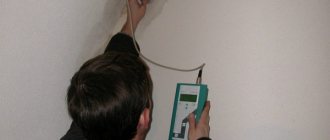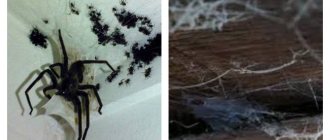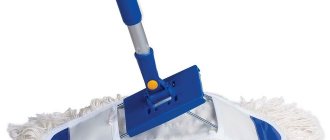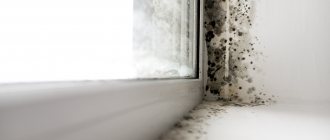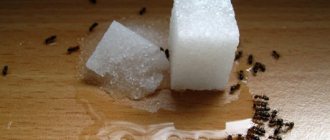Dampness on the walls is a common problem that can appear not only in an apartment, but also in a private house. It must be addressed immediately, because when the walls and corners become damp, not only the wallpaper begins to darken and peel off, but also mold appears.
Dampness on the walls can contribute to the emergence of various diseases, and become a gathering place for insects, mites and fungi . If the wall becomes damp, then you need to act immediately, and this article contains an analysis of the reasons and ways to solve them.
Why does this happen?
An apartment or private house often suffers from two or even more reasons. And increased humidity on the walls can appear at different times of the year. For example, in winter it is typical:
- Freezing of walls;
- Poor ventilation;
- Mold.
And at other times of the year, high humidity inside and outside the home is most common.
Now in more detail. Why does the problem of damp walls in the house arise?
External moisture
This problem is typical for apartments located on upper floors with a poor drainage system.
Causes of damp walls in the apartment and corners in the rooms: ways to combat mold
In houses or apartments, a situation often arises when corners or walls begin to become damp.
As a result, the wall darkens, the wallpaper begins to peel off, and a characteristic smell of dampness appears in the apartment. Such consequences do not add to the attractiveness of the room. But besides this, a damp surface in a room is an ideal environment for the development of mold. And fungal spores are the cause of the occurrence and development of numerous respiratory tract diseases. What is the reason for the appearance of moisture on the surface of the walls, and how to deal with this problem? What causes dampness in an apartment?
Reasons may be:
Consequences of wet walls
From the first days it may seem that wet walls will go away on their own. For example, after rains they dry out. But if a problem has appeared, it will appear more and more often. And then it will be very difficult to fix it.
As the wet walls continue, bad consequences will appear such as:
- An odor similar to that in the basement will appear.
- The wall materials will begin to deteriorate and peel off. Putty soaked in moisture will come off in whole layers and crumble, because its structure will be damaged. Then you will most likely have to pay for repairs.
- With flooring and wood coverings, the floor may become deformed. Because of this, creaks and cracks, as well as cracks, will appear.
- Furniture standing near such walls will also fall into disrepair.
- The moisture level will rise, which will negatively affect the health of humans and pets. When humidity is more than 60%, the risk of developing respiratory diseases and their exacerbation increases.
- Also allergies. It can also worsen or appear.
- A favorable environment will be created for microbes and bacteria, as well as fungi, including mold. These small living organisms also have a very detrimental effect on health.
- Skin rashes will appear. And if there are wounds or cuts, they will heal worse or even rot.
- It is also worth highlighting such an item as a poor microclimate for children. The fact is that their body is underdeveloped and susceptible to diseases. Thus, the child may suffer greatly.
As you can see, the consequences can be quite dangerous. It's time to talk about how to deal with dampness.
Causes of damp walls in an apartment: what to do and how to deal with mold
There is a saying: any apartment is good if it is your own. You can decorate the interior to your liking, equip a gym in the bedroom, get a cat or a dog. Having your own apartment has a lot of advantages, with occasional problems.
A common problem is damp walls. Dampness appears in late autumn and winter, when there is a difference in temperature inside and outside the home. It affects corner apartments and those located on the upper/lower floors of the building.
Damp wall
What to do
If such a situation arose after renovation, then it is enough to ventilate the rooms more often. If this is a cold period of time, then it is important that the room is warm enough.
If the batteries are not enough, you can use additional heaters. When the problem lies in ventilation, you can try to remove foreign objects that interfere with normal air circulation.
Insufficient waterproofing is a more complex problem. It is important to find the place where the water comes from and isolate it well. The main source is seams on the outside of the house. This task should only be solved by specialists.
Useful video webinar about wet walls and insulation. How does this happen and how to solve it.
Get rid of moisture outside
You can and should immediately begin to solve the problem if you know the reasons. Ventilating and heating is not the best idea, as it partially eliminates dampness. It's best to do something like:
- Isolate the weak area. To begin with, the problematic piece should be dried, the finishing removed, and insulated with bitumen mastic. And only then apply a deep penetration primer. The last stage will be plastering and wallpapering.
- Fix leaks. Most often the pipes will have to be replaced. It will often be impossible to do this on your own, especially in an apartment. This is done by special services.
- Sealing the seams between the wall and the balcony slabs. This way the problem will be solved not only with leakage, but also with cold.
- Floor treatment. If you have a basement and it is located under your house, then use a deep penetration primer. It penetrates into all the smallest pores and closes them. Then the joints are sealed and a waterproof base is laid.
- Foundation Insulation. Moisture enters the walls when groundwater rises above 1.5 meters. Under such circumstances, the corners and walls under the baseboards in the apartment will become damp. Horizontal insulation can solve this problem.
It is worth considering that sealing seams in one part of the apartment will only get rid of the problem for a while. For high-quality and long-term service of the building in proper condition, it is necessary to make repairs throughout the entire house.
Strengthen and correct ventilation
If the ventilation in the house is poor and the walls are wet, then you need to restore the ventilation. At the local level, this is very simple to do - you need to move the cabinet or other furniture. To clean the ventilation itself, you will need to remove the blockage in it. This can be done manually and using a vacuum cleaner.
For proper and high-quality ventilation in a private home, you need the help of specialists.
Disruption of air flow is caused by a violation of the layout or its change on the upper floors in a brick or panel house.
If the traction is still weak, you can strengthen it further. To do this, you need to make slits at the bottom of the doors. This will improve air circulation and traction will be better.
You can resort to using a special device to quickly dry damp walls. Such a device is inserted behind the grate in the kitchen and bathroom. Sometimes it has a timer as well as a valve. The hood should be checked every 3-4 months.
Get rid of moisture inside the house
If there is excess moisture in the house, then first of all you need to ventilate the room. It is especially important to do this for those who have plastic windows installed. They fit very tightly, which makes it bad for ventilation. In rooms where such windows are installed and the moisture level is high, it is recommended to open the windows for ventilation as often as possible.
Another way to get rid of high humidity is to install heating or purchase additional heat sources. At low temperatures, the moisture concentration becomes higher, so this option is very promising.
The third option would be to purchase a special device - a dehumidifier. It will make your stay in the apartment comfortable and safe by leveling out the moisture level.
Insulate the room
Living in a cold, damp apartment is not comfortable, and it is also a health risk. There are several options to solve this problem. The first is to insulate the room using stronger heating. This method has a right to exist, but it requires an increase in heating costs.
The best way to prevent freezing is to insulate external walls. For owners of the first floors or private houses this will be possible. If the problem starts from the 2nd floor, then professional industrial climbers will deal with this.
You can also insulate the room from the inside. This method is not good. There is a risk of condensation accumulating under the insulation, which will also lead to a deplorable situation and the problem will get worse. Crack and mold will develop.
If the walls are not thick enough, an additional layer of cladding should be made. Brick is often used for this purpose.
Remove mold
Since mold can cause serious consequences, it should be removed quickly. To do this, the following procedures are carried out:
- The facing layer is removed. At this stage, you need to wear special clothing and a respirator to prevent small dangerous particles from entering your lungs. Mold should be removed using a spatula and a metal brush.
- Antiseptic treatment. It is possible to use homemade remedies. This includes: baking soda, bleach, vinegar. The best choice is to use specialized tools.
- After 2-3 hours after treatment, you need to brush again. This is done in order to eliminate mold decay products. After this, it is treated with warm water and dried using technical devices.
- After 24 hours, coat with a deep penetration primer in several layers.
- Apply plaster. It is better to choose materials with antifungal and water-repellent properties.
- Wall decoration. You can paint or wallpaper.
Excessive indoor humidity
The simplest reason, in terms of elimination, is high humidity in the apartment. It is possible that the appearance of pockets of dampness was preceded by the replacement of windows in the room. New windows closed the openings more hermetically and worsened the ventilation of the room. In some cases, in order to avoid dampening the walls of the apartment, it is enough just to ventilate the room more often.
If this is not enough, or the problem occurs in a room with potentially high humidity, for example, a kitchen, then you can try to improve the quality of ventilation. To do this, you can put a fan on the vent. Thus, ventilation will turn from natural into forced supply and exhaust with greater productivity.
Where to contact
If all possible options for eliminating dampness do not help, then you need to write and submit a statement to the management company. In 2022, it will be drawn up in writing and in two copies. The paper should contain detailed information about when the corners or walls began to get wet, and an exact indication of the location.
ATTENTION! After submitting your application, it is important to ensure that it is recorded. The applicant must keep one copy with a mark.
The next action of the management company should be to send a technician to inspect the residential premises, based on the results of which a report on the presence of dampness and the reasons for its occurrence will be drawn up. The apartment owner must request a copy of this document.
As soon as the act is drawn up, the management company must decide on the option for repair work, as well as the time frame by which it will be completed. It is advisable for the apartment owner to take a copy of each document. If the repairs are not carried out or the period is significantly delayed, then these copies can be contacted with the relevant authorities.
Sample application to the Criminal Code
Sample complaint to the Housing Inspectorate
Then you can file a complaint with the housing inspectorate. It can also be submitted collectively, where all participants sign and the date is indicated. Such a complaint is considered within 30 working days. However, practice shows that it is considered in a shorter period of time. Most often this happens within 14 days.
Sample application to the Prosecutor's Office
The next authority you can subsequently contact is the prosecutor's office. A complaint to this body must be made in free form. As a rule, it is filled out in an official business style.
Obscene language and the use of jargon are unacceptable. And also you shouldn’t rate the problem. You need to restrain your emotionality. The government agency has the right to leave such applications without consideration.
Another important point is that errors, whether punctuation or spelling, should not in any way affect the acceptance of the complaint. At the end there is a signature and date.
Sample application to the Court
The last authority to which you can turn is the court. It should finally resolve your problem. But most often it all ends in the previous organs.
Ways to get rid of dampness
You can do this on your own or contact specialized organizations.
Bitumen mastic
Getting rid of external moisture
Some experience will help in resolving the issue. If it is missing, follow our recommendations:
- find a weak area that lets water in;
- insulate it with bitumen mastic;
- remove the damaged coating from the inside, apply mastic, plaster the surface;
- Cover the treated area with primer, paint or wallpaper.
Ventilation and electric heating will partially correct the situation.
Leaks in an apartment building are dealt with by building maintenance services.
Exhaust fan in the bathroom
Restoring ventilation
Local ventilation problems can be easily eliminated. they remove the cause of the ventilation problem, pull back the curtains, and rearrange the closet.
Blockages in ventilation shafts can be removed independently if they are located near the grille. Remove the protective grille and vacuum or clean the clogged area.
A clean, draft-free vent requires professional help. Solving the problem on your own will not bring results.
Often, ventilation problems occur due to the fault of neighbors above. Illegal redevelopment of housing alters the ventilation riser, which affects the air movement of other apartments. Specialists will be able to detect innovations and fix the problem. Cleaning out shafts in old houses is also their task.
Is the ventilation system normal, but the air flow is bad? The reason is plastic windows, open them more often, put them on micro-ventilation.
Installing forced ventilation is an excellent solution. Poor air flow into the apartment requires the installation of supply ventilation, poor removal requires installation of exhaust ventilation. Look for compact, cheap devices that provide normal air exchange.
Instead of a grille, install an exhaust fan in the bathroom. There are fans with a timer that turn on and off periodically. It is advisable to purchase a fan with a check valve. If the neighbors install a similar device with more power, it will drive air back into the apartment. The kitchen must be equipped with a hood.
Elimination of high humidity
Dealing with moisture on the walls due to the basement is difficult. There are many reasons: high groundwater levels, improper waterproofing. Basement drainage should be carried out by specialists.
Dampness enters the apartment through microscopic cracks in the floor. Remove the floor covering, treat the base with mastic, put the covering in place, treating it with an antifungal agent. Carefully seal the seams with sealant.
Insulation from the outside
Elimination of freezing
The best prevention of freezing is insulation of external walls. Owners of the first floors can do this on their own; everything above is within the competence of specialists from construction companies.
Internal insulation has received mixed reviews. On the one hand, the interior decoration will lead to the accumulation of condensation between the wall and the insulation; on the other hand, the lack of external insulation is a way out of the situation.
Stages of internal insulation:
- The walls are cleaned of old wallpaper or paint.
- The surface is leveled.
- A frame of metal profiles is mounted and secured to the wall with self-tapping screws and dowels.
- Insulation is placed in the frame cells.
- Everything is covered with plasterboard.
- The surface is plastered.
An alternative method of insulation is “warm” plaster; instead of sand, the composition contains materials with increased thermal insulation properties (expanded clay chips, polystyrene foam grains, sawdust, etc.). Has high adhesion and does not require wall leveling. Apply in the usual way.
Black mold
Mold control
Black mold forms on walls and ceilings - microscopic fungi, the spores of which are carried through the air, landing on building materials. In a favorable (humid) environment, spores develop and produce mycelium (mycelium).
Mold control:
- Remove wallpaper and paint from the walls - you need to work in a respirator so that the fungus does not enter the respiratory tract. Working tool – hard metal brush or spatula.
- Treat the surface with an antiseptic - previously actively used: vinegar, baking soda, hydrogen peroxide. Some people still use home methods to combat fungus today. Experts advise using factory-made antiseptic preparations (Fongifluid, Senezh Effo, etc.). They are more efficient.
- After a few hours, go over the wall with a dry brush, remove the decay products of microorganisms, wash with warm water, and dry.
- After 24 hours, apply a deep penetration primer.
- When it dries, apply plaster.
- The final stage is painting or wallpapering. You need to paint with products for wet rooms. Glue is used with antifungal properties.
Foundation waterproofing
It happens that dampness in the house is caused by the fact that the foundation is poorly insulated. If its waterproofing is insufficient, groundwater when raised above 1.5 m can penetrate into the walls. In this case, they will get wet, mold will appear under the baseboard and in the corners, the plaster will begin to fall off, and the wallpaper will deteriorate. However, if horizontal waterproofing of the foundation is done correctly, it can prevent the penetration of groundwater.
Why does the foundation get wet?
Remedies
Having found the cause of the formation of high humidity and eliminated it, you can begin to dry the room. Expensive methods such as the use of heat guns are only necessary to eliminate the consequences of flooding or for very large rooms. In an apartment or private house, the following measures can quickly eliminate dampness on the walls:
- Heater – the device provides air convection; even a small heater will cope with the task in 1-2 days;
- Household dehumidifier - the power of the unit is determined by the size of the home; to eliminate dampness on 50 m², a device with a power of 400 W is sufficient;
- Silica gel is a substance that absorbs moisture and organic vapors from the air; for household use it is supplied in the form of granules, they need to be spread out in a damp room; drying can last up to a week;
Finally, dampness is negatively affected by rising temperatures in the home. Using the heating system or fireplace at full power, you can dry the walls relatively quickly. However, the method is not suitable for houses made of timber - due to direct exposure to high temperatures, wooden structures can crack.
Preventing dampness
If certain recommendations are followed, the appearance of dampness can be prevented or minimized. Basic Rules:
- It is advisable to dry laundry outside the living room or with the hood running.
- During cooking, the dishes must be covered with a lid to prevent steam from escaping from them.
- In the bathroom, where the highest concentration of moisture is contained, as well as in the kitchen, you need to periodically clean the ventilation openings from clogging. Also, these rooms require systematic ventilation.
- In a private house, you can try to insulate the attic space. In addition, you can cover the walls with waterproofing material.
- It is recommended to use flammable substances less frequently, such as paraffin, which contributes to the appearance of moisture.
- Correct errors in the heating system in a timely manner.
- You can use a dehumidifier to reduce humidity. This device easily fixes the problem. It is also quite compact, which makes it easy to move it to different rooms.
Experts recommend installing fans with a built-in humidity controller in the bathroom. If the humidity rises, it reacts automatically, eliminating excess moisture in the air.
ATTENTION! It is important to monitor the condition of the apartment and prevent the walls from becoming damp.
The fight against excess dampness in an apartment or in an individual residential building cannot be postponed until later. It must be started immediately, as this is a rather labor-intensive process, sometimes requiring financial costs.
If you accurately determine the cause and choose the right method to eliminate it, then you can forget about dampness for a long time.
Prevention
So that residents do not have to worry about how to remove dampness from the walls, it is important to know effective ways to prevent its occurrence. It is enough to take a number of simple measures:
- Ventilate the room for at least 10-15 minutes every day, creating a draft;
- Dry clothes only on the balcony or outside;
- Equip a ventilation system in the kitchen;
- Use air filters - models equipped with a Nera filter are more preferable;
- Install air conditioners in combination with fungicidal filters against mold fungi;
- Do not overuse wet cleaning.
It is not so easy to completely remove fungus from dampness on the walls. It often reappears from spores that survived treatment deep in the floor structure.
Ensuring your own health and safety of your home is not so difficult. To do this, it is enough to follow the basic rules for caring for the premises. And when mold appears, under no circumstances should the problem be left to chance.
Remedies
Mold fungi are difficult to remove. In all cases, the final coating will have to be completely removed - wallpaper, plaster, and if the damage is deep, putty to the very base of the wall. The only exception may be a painted surface, since mold has difficulty penetrating a layer of paint, but spreads more strongly over its area.
The safest way to remove mold and dampness from your home is with the help of chemical compounds, some of which are easy to prepare at home:
- Antiseptic primers are special products with a high content of fungicides; with their help you can process the wall to a depth of 0.5 cm;
- Household bleaches - any type containing sodium hypochlorite will do;
- Hydrogen peroxide - 3% composition is used; due to the whitening effect, it is not suitable for treating painted surfaces;
- Potassium permanganate - found in everyday life in the form of a solution of potassium permanganate; used as a mixture - 15 g per 1 liter of water;
- Vinegar and citric acid are effective at the initial stage of mold development.
Even after eliminating the fungus, a characteristic unpleasant odor remains in the room. A simple method to get rid of it is to treat the floors with a baking soda solution. To prepare it, 15 g of the substance is dissolved in 100 ml of water.
The main disadvantages of insulation options
External insulation of a cold wall
When the insulation is located on the outside of the wall, the penetration of cold air into it is limited. But at the same time, the warm air that is inside the room heats the wall, and the zero isotherm shifts to the outside of the wall or, perhaps, even to the insulation itself.
And the water vapor that forms inside the room quietly penetrates the wall and disappears into the atmosphere.
Internal insulation
If the insulation is installed on the inside of a cold wall, then the warm air in the room will not be able to warm it up, because the insulation will prevent this. The wall will most likely freeze through, and the temperature isotherm will shift inside the insulation.
The steam will pass through the insulation without any special obstacles and will begin to accumulate on the inside of the wall, after some time turning into water. It, in turn, will either flow down the finish or accumulate inside the insulation, which will negatively affect its properties. To prevent steam from passing through the insulation, you should use foil.
After the insulation of the cold wall inside is completed, new problems will appear that will need to be solved:
- Loss of room space.
- If there are radiators on this wall, they should be moved.
- If you installed foil insulation, then you need to solve the issue with ventilation, because now the steam does not escape into the walls - they become warm, but damp.
- After internal insulation, the corners on the floor and ceiling will most likely begin to freeze.
- Window slopes and the upper part of the window opening will also need to be insulated.
No matter how well the vapor barrier is done, liquid will certainly accumulate somewhere and begin to destroy the wall material. The likelihood of fungus appearing increases, but it will be difficult to see behind the finish.
Optimal microclimate in the house
Much depends on the indoor microclimate, including the health of the inhabitants. But the structure of the house, the safety of the walls, floors, and ceilings suffer no less from temperature and humidity.
To avoid costly repairs, it is important to maintain an optimal microclimate in the premises. This for humidity is no more than 60% in the winter and 65% in the summer. For air temperature – at least 15°C. It is not difficult to notice a deviation from the norm; dampness is manifested by the following signs:
- Condensation on glass and sections of walls connected to the ceiling;
- Characteristic “wet” smell;
- Swelling of wooden structures; expressed, for example, in poorly closed doors;
- Damp salt and sugar.
At the first sign of high humidity, do not hesitate. If you do not remove dampness from the walls in time, mold will soon form. Removing it will take weeks and may lead to the need for cosmetic repairs. Determining humidity above normal “by eye” is problematic; a simple home hygrometer will help with this.
Note that high humidity has a destructive effect not only on wooden structures, leading to their rotting, but also on stone ones - brick, concrete. Soaked in water, they crumble, a process that accelerates in regions with cold winters. Metal structures suffer a little less, but they are also susceptible to corrosion.
Reasons for education
Before you deal with moisture, you need to find its source. Often dampness on the walls is the result of a complex of reasons. The most common of them:
- Leaks - occur when the water supply system, sewer pipe, or roof roof is damaged;
- Poor ventilation;
- Unsuitable waterproofing of floors and foundations;
- A large number of house plants;
- External factors - proximity to a river, heavy rains, groundwater, etc.
However, the most important factor in high humidity is the person himself. Under normal conditions, an adult produces up to 2.5 liters of water vapor per day, including that during cooking, washing, water procedures, etc. Even a slight deviation from the norm, for example, when drying clothes in the bathroom, is fraught with consequences.
Related article: How to attach foam to a concrete wall

